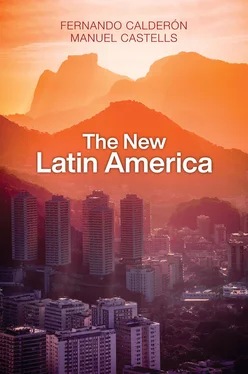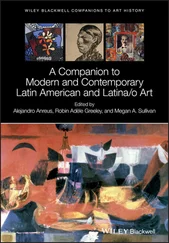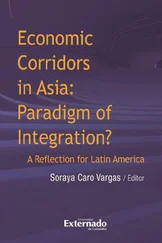Three Cases: Lithium in Jujuy, Soy in Carlos Casares in the Humid Pampa in Buenos Aires Province, and Unconventional Hydrocarbons in the Vaca Muerta
In Argentina, as in other countries, 1we can find the coexistence of different types or models of corporate development and informational extraction. At least three such models coexist in this context.
In the province of Jujuy, in the new extractive market for lithium, productive, organizational, and informational processes are mainly linked to transnational corporations. This creates a dual dynamic. On the one hand, there are the simple extractive processes, which, especially during the early stages, rely on local manual labor. On the other hand, there are processes of complex reworking and mineral processing that turn raw materials into a series of technological and informational products, relying in large part on labor from abroad. According to information offered by the company Sales de Jujuy, in 2017 it created 270 jobs, of which around 120 were for workers who resided in local communities (Pragier and Deluca, forthcoming: 37).
Sales de Jujuy S. A. is a partnership that brings together the Japanese car manufacturer Toyota Tsusho, an Australian mining company called Orocobre Limited, and a company known as Jujuy Energía y Minería, Sociedad del Estado, based in the province of Jujuy. Financing is mainly provided by the Mizuho Bank of Japan, which also underwrites the Japan Oil, Gas and Metals National Corporation. Of course, agreements between extractive corporations and the multinational corporations that require their products presuppose that the latter guarantee purchases in a given price range.
In the case of YPF, S. A., based in the Vaca Muerta formation in the province of Neuquén, we see a combination of industrial, oil-based extractivism and complex processing by technological and informational means, in networks that include systems for the importation and processing of gravel in China, wells for the extraction of gas and oil, digitally monitored through nodes installed by the corporation itself. In this context, new horizontal fracking technologies are also noteworthy, as are various commercial and financial systems, organized and managed through networks. This corporation is part of a global network of networks.
In the case of the soy produced by the company Los Grobo Agropecuaria, one of Gustavo Grobocopatel’s companies, the systems of organization and management are totally computerized. They include broad networks of workers, divided into specializations according to the activities they perform; they range from young people processing algorithms to experts in finance at the global scale. From its headquarters in Carlos Casares, a range of activities are organized and completed, from the extraction of soy to the global promotion, marketing, and financial management of the company. It is worth pausing briefly to consider this company’s workings.
The main business unit, based in Carlos Casares in the Province of Buenos Aires, is an informational corporation that is highly innovative and that is organized by a techno-informational division of labor, according to which various centers work on specific areas relevant to the different stages of production and circulation. These centers are interconnected as well as connected to other glocal networks. It is of particular interest that they are also associated with universities’ systems for agricultural research, and in particular with the Instituto Nacional de Technology Agropecuaria and the Universidad de Buenos Aires.
The company’s operational centers include sites for studying specific dynamics involved in technological production (at specific times of year) as well as for the processes of planting, harvesting, and storing crops in Carlos Casares. They also include sites for complex financial and commercial transactions, for the administration of trade, and for the development of production strategies. There are also sites for the study of business, sales, and projections for the price of soy on the various international stock exchanges. These, too, are, from the first, integrated into and connected with other sites in the country and the region where scientific and technological research takes place.
In cultural terms, this has generated a culture of informational work that valorizes innovation and the scientific and technological capabilities of workers. These qualities are seen to be pivotal for agricultural and land development, and this has influenced all other producers in the Humid Pampas as well as others in other regions and other countries in South America and the Caribbean.
In political terms, despite the partisan politics of the municipality and the region, the company’s activities and its efforts at social integration and cultural participation (for example, in public schools) are highly valued by local citizens. Opposition to the company comes mainly from outside Carlos Casares.
In a report by Leila Guerrero for the magazine Gatopardo , Gustavo Grobocopatel is quoted as saying:
Because of a flood, we learned to farm in fields other than our own, and I realized that it did not make sense to have land of your own. That you could grow enormously by planting crops in the ground with very little money and very quickly. After this, things got more sophisticated, but I think that this was the conceptual origin of our business model: the realization that you can farm without land, without capital, and without labor. Without land, because you rent; without labor, because you outsource it; and without capital, because they lend it to you. I don’t know if we are the inventors, but we are the people who have gone farthest with this idea.
Nevertheless, as Wahren adds, all of this takes place in a very complex territorial context. In the late 1940s, Argentina used only 10,000 liters per year of agrochemicals, a figure that increased to 3.5 million by the 1970s. But beginning in 1996 (the year when the use of genetically modified soy seeds was approved), more than 200 billion liters of glyphosate were added to the 69 billion traditional agrochemicals already in use. According to some sources, the former figure should in fact be closer to 300 billion. In other words, this is an unprecedented situation, involving 19 million hectares of genetically modified soy and around 370 billion liters of agrochemicals that have not been proven to be harmless, since the precautionary principle has not been observed.
In terms of their relations with and ways of organizing their workers, these three companies differ widely from one another. In Jujuy, Salar de Olaroz interacts with Andean community organizations, made up mostly of young people who participate in the company’s activities by performing both the hardest and the simplest tasks. It is also worth noting that there are communities that have refused to participate in the company’s undertakings. In other cases, communities have been dominated and divided by relations of distrust across the local social spectrum.
In Vaca Muerta, at the highest level of the stratified workforce, there is a sort of “worker aristocracy” that is highly technologically skilled and well paid. These workers shore up a culture of oil-drilling that has a long history and has been privileged in the region and in Argentina. They have their own trade unions that take practical measures to advocate for their interests. On the other hand, there is also a set of part-time and temporary workers who sustain the extractive system in a different way. Another key factor in the company’s success is the outsourcing of various activities both to other national companies and to international corporations.
Mapuche communities are key actors and significant territorial presences in this context, as are the labor organizing networks and non-governmental organizations to which Mapuche people belong. These networks are international in their reach, connecting them with Chilean Mapuches, for instance, and Sioux tribes in the United States. These communities’ critique of Salar de Olaroz is primarily ecological in nature; it points to the possible contamination of groundwater on their territory. Other labor and business organizations in the region interact and participate in oil-drilling ventures. In this context, research units from the Universidad del Camagüey stand out, making significant contributions.
Читать дальше












